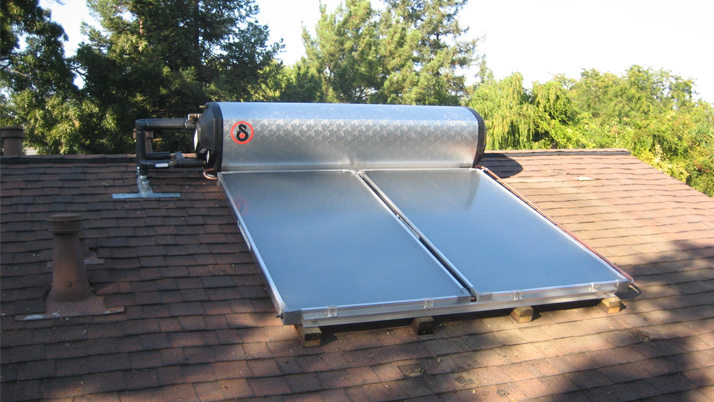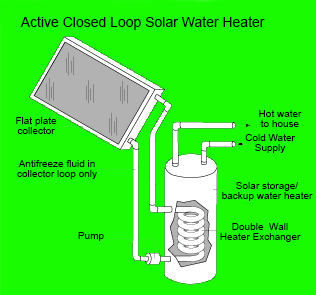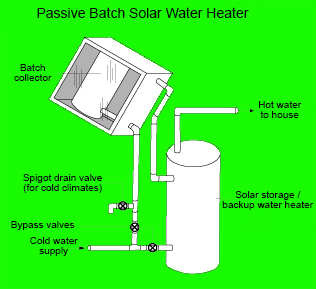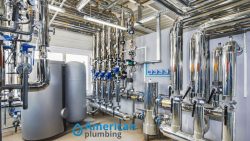
Solar Water Heating System
Solar water heaters are commonly referred to as solar domestic hot water systems by the plumbing industry. It doesn’t matter how Solar Water Heating Systems are referred to. They has a few key points that set them apart from traditional water heaters. Obviously their main selling point is the free fuel source. Mother nature provides the sunshine for you. There is no other cost effective way to produce heated water for your house. Solar Water Heating Systems can be used in any climate unlike traditional water heaters. American Plumbing will assist you in determining the ideal Solar Water Heating System for your household.
The way a solar water heating system works is not overly complicated. They have two main components – the storage tanks and solar collectors. The solar collectors harvest the free energy provided by the sun. There are 2 varieties of solar water heating systems. The active type has pumps that circulate the water with controls opposed to the passive type which doesn’t have either.
Active Solar Water Heating Systems have 2 distinct flavors Direct Circulation and Indirect Circulation. The Direct Circulation system has pumps that circulate your house’s water thru various collectors which are then piped into your house. These systems work the best in an environment that doesn’t freeze often if at all. Indirect circulation systems are commonly used in cold weather climates which are subject to freezes. The pump circulates a non freezing heat transfer fluid thru the collectors and a heat exchanger. This process then heats the water that flows directly into your house.
Here is a graphic of an active closed loop solar water heating system. The large flat panel referred to as the flat plate collector has a connection to your solar tank via 2 pipes. Your solar storage backup water heater has one pipe running thru a cylindrical pump located at the bottom of the tank. As this pipe turns and bends its way around the tank it becomes a coil called a double wall heat exchanger. The pipe undergoes a transformation from outside the storage reservoir then into it where it becomes the coil completing the loop to the flat plate collector. The anti-freeze fluids run thru the coil and the whole collector loop. The 2 pipes which come out of the top of your solar water storage tank have distinct purposes. The cold water comes in via one pipe and the other pipe brings your heated water to the house.
Passive solar water heating systems generally cost much less and but their efficiency comes into question. With that being said passive solar water heating systems are much more reliable and have a longer lifespan. Maintenance is not an issue for either passive or active solar water heating systems. Like the active systems, the passive has 2 flavors. An integral collector storage passive system and a thermosyphon system. The Integral collector storage passive system operates optimally in warm weather environments that are not subject to freezing temperatures. They are best suited for homes that have a high demand for hot water needs during the daytime and at night.
Thermosyphon systems have the water flowing thru the system as the warmer water rises and the cooler water sinks. The collector in these cases have installation done below the storage tank so that the warmer water will be risen into the tank. There is only one caveat that should be taken into consideration. The roof design must be able to withstand heavy payloads. A thermosyphon system should be discussed with a contractor to ensure the roof has the capacity to accept it. Most newer roofs don’t usually have an issue. One last thought about Thermosyphon systems is that they carry a slightly higher price tag than the integral collector storage passive system.
Here is a graphic of a passive batch solar water heater. The cold water has 2 entry points, a batch collector or the solar storage backup water heater tank. This varies depending on the orientation of the bypass valve. If the valve for the batch collector is in the open position, a vertical pipe (cold weather environments the pipe will have a spigot drain) then brings the water up and then into the batch collector. The batch collectors are constructed of a large box holding a tank that is immersed with a glaze that points directly towards the sun. Water is then heated up in this tank, now the other pipe will bring the hot water from the batch collector into the solar storage backup water heater. The last part of the hot water’s journey is to the inside of your home.
If you have any questions about solar heating solutions give American Plumbing a call.
954-584-7733






